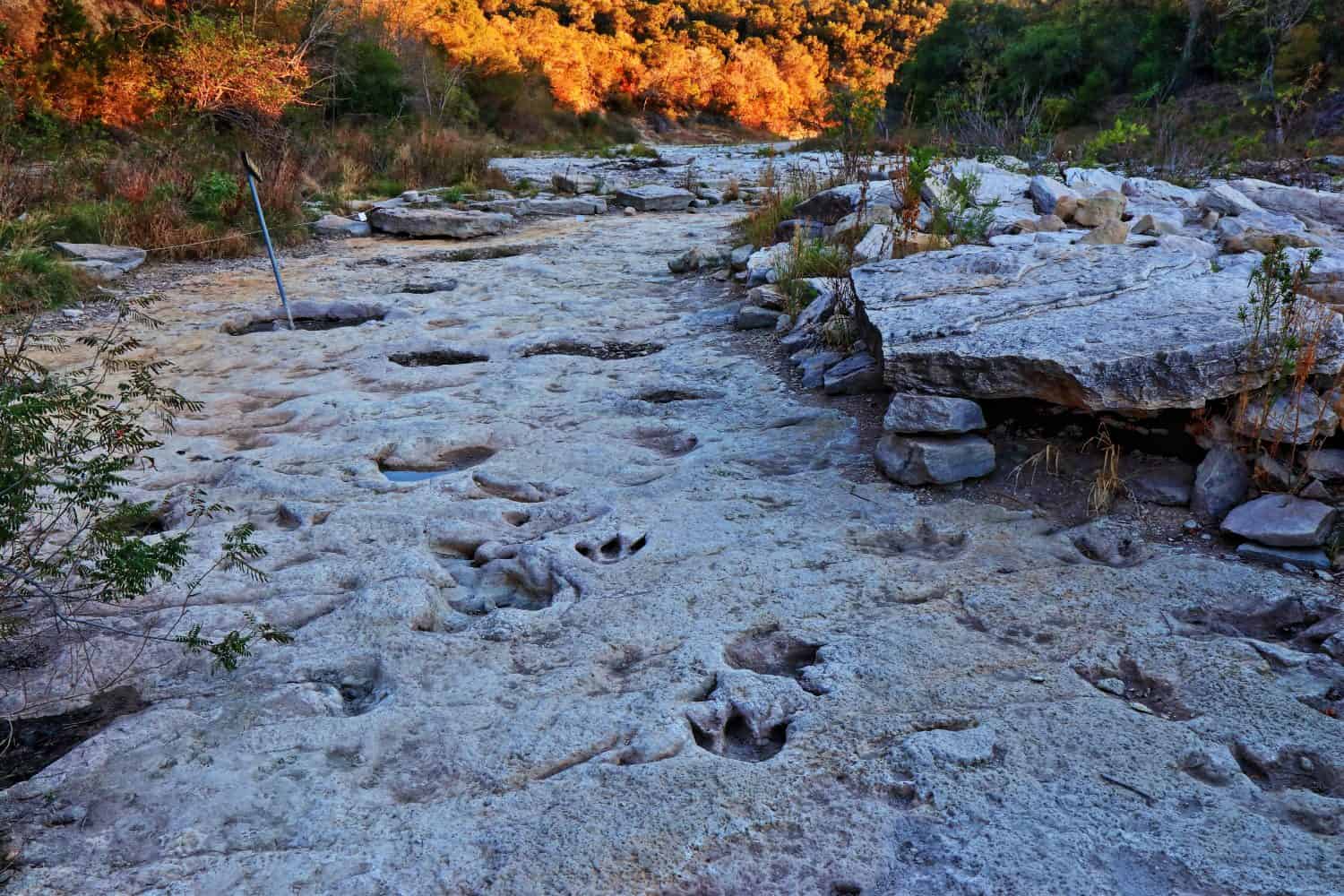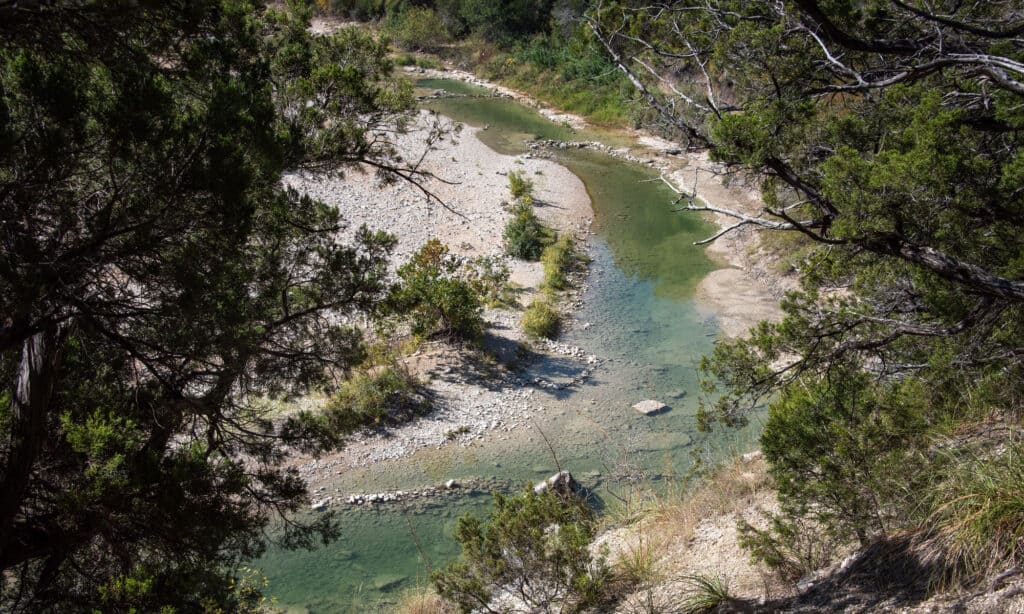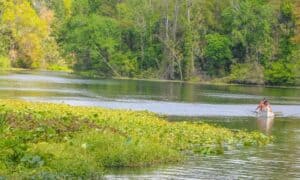Dinosaur Valley State Park, located in Glen Rose, Texas, is one of the most beautiful and exciting parks in all of the Lone Star State.
The park is 1,587 acres in size and first opened for entry in 1972. However, the land has been inhabited for thousands of years.
Who were some of the park’s earliest visitors?
Dinosaurs, of course!
Dinosaur Valley State Park is home to hundreds of authentic dinosaur tracks. Preserving these tracks was the intent of establishing the state park altogether.
Things To Do at Dinosaur Valley State Park

See fossilized dinosaur tracks in the Paluxy Riverbed at Dinosaur Valley State Park in Glen Rose, Texas. Image: Daniel Koglin, Shutterstock
©Daniel Koglin/Shutterstock.com
There’s a lot to do at this park. All standard state park activities are fair game, including hiking, biking, camping, and if you have a horse, horseback riding.
Dinosaur Valley State Park is also home to a large portion of the Paluxy River. That means that while you’re visiting the park, you can go for a swim or cast a line and fish!
Of course, the main attraction of Dinosaur Valley State Park is walking the dinosaur tracks. They are located along the riverbed of the Paluxy. At times, when the area is particularly wet, it may be difficult to make your way to the tracks. Trails can be closed due to weather, which can inhibit finding the tracks.
Before you head to Dinosaur Valley State Park, visit the park’s Facebook page for notes on trail closures and visibility. That’s the easiest way to make sure you spot what you’re coming to look for!
History of Dinosaur Valley State Park
The area of Dinosaur Valley State Park has a rich history. Originally, the park was home to Native American tribes. Archaeologists have dated human evidence in the area back to well over 6,000 years ago. So while the park was only established in 1972, the land has been inhabited for a long time!
There are a few different potential tribes that occupied this land prior to the arrival of the Europeans. Tonkawa, Wichita, and Comanche were suspected to have enjoyed the land in and around what is now Dinosaur Valley State Park at various points in their history.
The area was settled in the mid-1860s by Europeans. In 1908 a massive flood uncovered areas of The Paluxy River previously hidden. A nine-year-old boy who was enjoying splashing on the shore found something that looked pretty exciting: a track! Obviously, he wasn’t sure who or what the track belonged to.
Nothing was really done about these tracks until about twenty years later when a historian and fossil collector from New York City took a trip to Texas to explore the area. R.T. Bird identified the tracks and they were used to reach new conclusions about dinosaurs. The type of tracks located in the riverbed had never been seen before, making it an exciting new discovery!
Finally, in 1972, the land was designated as Dinosaur Valley State Park. The purpose of this designation was clear: to protect the invaluable tracks that lay in the land here.
Facts About the Tracks at Dinosaur Valley State Park

Dino tracks at Dinosaur Valley State Park indicate the size of the creatures that roamed there was massive. Image: W. Scott McGill, Shutterstock
©W. Scott McGill/Shutterstock.com
The tracks at Dinosaur Valley State Park are extremely unique and have had a big influence on the study of archaeology. Here are a few facts about them!
1. Theropod and sauropod tracks are both visible at Dinosaur Valley State Park.
The major difference between theropods and sauropods is the number of legs. Theropods have two legs, while sauropods have four. Another difference is that sauropods are quite a bit larger than theropods!
R.T. Bird, the first scientist to look at the tracks, is the one to determine that there were both theropod tracks and sauropod tracks visible at the park!
2. The tracks at Dinosaur Valley State Park taught archaeologists something about sauropods.
Until the tracks were discovered, scientists believed that sauropods stood on their back legs, while water supported the rest of their weight.
Upon the discovery of the tracks, archaeologists were able to come to a new conclusion: sauropods stood on all four legs!
3. The tracks likely belong to an Acrocanthosaurus and a Sauroposeidon proteles.
The theropod tracks are thought to belong to an Acrocanthosaurus. These dinos are relatives of the Tyrannosaurus rex. They’re slightly smaller than the T-rex, but still over 20 feet tall! Wow!
It took a bit of time to sort out which dinosaur the sauropod tracks belonged to, but scientists have concluded they are most likely Sauroposeidon proteles tracks. These dinos were massive, weighing over 40 tons and spanning beyond 70 feet in length!
When is the best time to visit Dinosaur Valley State Park?
Dinosaur Valley State Park is the most busy from March to November. The weather in Glen Rose is pleasant for much of the year, so if you’re looking for less crowds, you can check out the area during the winter, too!
Another point to consider is the weather. Because the tracks are in the riverbeds, it’s best to head to Dinosaur Valley State Park when the weather is dry. This is generally in the late summer. The rainiest months are April and May, so if you’re hoping to check out the tracks, you may want to avoid coming to the park during those months!
As recommended above, keep an eye on the Dinosaur Valley State Park for weather updates and trail closure news. That’s the best place to check before you take the trek to the park.
What is the cost of visiting Dinosaur Valley State Park?

Take the whole family out to explore Dinosaur Valley!
©Stanley Ford/Shutterstock.com
Coming to visit Dinosaur Valley State Park is pretty cheap! Children under 12 get into the park for free, while adults cost $12 a head.
If you have a Texas State Park Pass, entrance to Dinosaur Valley will be free.
What are the best trails to explore at Dinosaur Valley State Park?
Dinosaur Valley State Park offers a long list of trails at varying levels of difficulty. It’s a fantastic place to come with your family because you can select the perfect trail fit for your ability! Here are a few, though the Dinosaur Valley State Park has a whole list of their trails here.
Easy Trail: Paluxy River Trail
This trail is just under two miles long and marked with an easy level of difficulty. This trail wanders by a significant amount of dinosaur tracks, so it’s an awesome path for all dinosaur hunters! Expect this route to take a little over an hour to complete (though you’ll probably want to stop to take in the history you find on the way)!
Moderate Trail: Rocky Ridge Trail
This trail has some of the best views you can get in Dinosaur Valley State Park. It’s a mile long and marked as moderate difficulty. This trail takes an hour to hike and you can expect to see some beautiful views of the area!
Challenging Trail: Cedar Brake Outer Loop
The longest trail Dinosaur Valley State Park has to offer is the Cedar Brake Outer Loop. At 7.5 miles, this challenging hike will take you all over Dinosaur Valley State Park. This hike is estimated to take about three and a half hours, but is sure to satisfy your desire to see the park!
What wildlife can be seen at Dinosaur Valley State Park?

This golden-cheek warbler can be spotted in Central Texas in the spring and early summer.
©Michael Armentrout/Shutterstock.com
While Dinosaur Valley State Park is notably home to some incredible fossils, there are also some amazing living things here, too! White-tailed deer, fox squirrels, and beavers all live within the park. If you’re a birder, keep your eyes out for the endangered golden-cheek warblers who live in the park from March to July.
The photo featured at the top of this post is © W. Scott McGill/Shutterstock.com
Thank you for reading! Have some feedback for us? Contact the AZ Animals editorial team.







